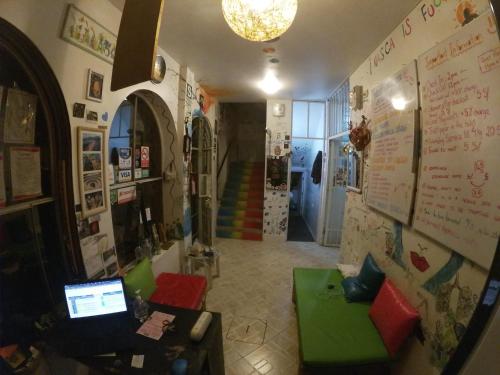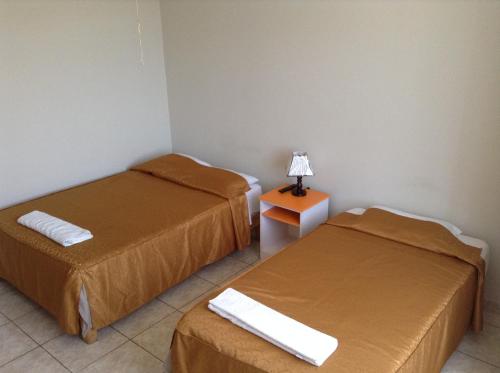The sun is setting by the time I leave the desert near Nazca, after a day that began by visiting the famous Nazca Lines.
The sunsets in this part of Peru dominate the sky and the land – as the early evening approaches, it’s as though a blind of black is being pulled down on an orange window until the last sliver at the horizon is covered.
The shadows on the sand grow longer until they are consumed by the dark.
You don’t want to still be out here in the Nazca deserts when the light is gone. You can’t be too sure what the mummies do at night.
For the easiest way to visit Chauchilla Cemetery, I would recommend this good guided tour from Nazca.
At the Chauchilla Cemetery, the dead have survived for hundreds of years. Almost two thousand years, in some cases. People were first buried here in about 200 AD and the burials continued for up to 700 years.
When you visit Chauchilla Cemetery yourself, though, it’s not just a field of graves. Don’t imagine headstones or closed tombs.
What you find are the bodies themselves. Skeletons – many still with hair or even some skin – wrapped in clothes, staring at you from the sunken eye sockets that seem more alive than they should for people born a thousand years ago.
The way they are posed, they appear to be sitting patiently in the corner of their sunken pits, their subterranean domains.
Some are looking up towards the visitors standing at the edge, others seem to be focused on the earthen pots and other belongings in front of them.
They are all clothed, their bodies hidden beneath material that has turned to rags – but dressed realistically enough that you wonder whether they chose their own outfits.
Are the bowls on the ground in front of them their last supper or their next meal?
The preservation is remarkable and it’s due to two main reasons.
The first is the way that the bodies were prepared for burial. They were covered in embroidered cotton and then painted with resin before being put into tombs made of mud brick. This kept out insects and slowed bacteria that might have destroyed the bodies faster.
But another factor – an important one – is the dry climate here in the Peruvian desert. Bodies do not decay in the same way they do in most of the world.
In these tombs, the flesh lived on. The souls? Well, who knows for sure.
The Chauchilla Cemetery is part of the heritage of the Nazca culture, which was based in this region of Peru from about 100 BC to 800 AD.
The most famous legacy of these people are the Nazca Lines, one of best things to do in Peru.
The enormous shapes and patterns that were created in the desert and are best viewed from a plane above. That’s when you can really see the animals and images hundreds of metres wide in the flat land below.
But a trip to see the mummies is also a worthwhile trip when you’re here. Most tourists just come for the day, take a flight to see the lines, and leave. But those pictures in the desert are just an ancient remnant of a long-lost culture.
These mummies… well, you could say the same thing. But perhaps there’s a stronger connection, a more spiritual one, something we can’t quite define.
Look into their eyes and tell me there’s not still some life in these bodies.
Visit the Chauchilla Cemetery
The Chauchilla Cemetery is almost 30 kilometres drive south from the main town of Nazca, about six kilometres along a turnoff from Peru’s main Highway 1.
It takes about 20 minutes to drive there from Nazca and there is no public transport.
If you don’t have a vehicle, a tour is going to be the best option. Even if you do have a car, you may appreciate having a guide.
I would recommend this good guided tour from Nazca, which also includes a stop at a local artisans workshop.
Or there are some other good (and, to be honest, very similar) options here:
All the tours tend to take between two to three hours in total (including hotel pickup). If you’re visiting Chauchilla Cemetery independently, you’ll still want to spend almost an hour there, so the total time including transport is going to be close to two hours.
Although it looks like a big open area with no fences, you need to pay for admission.
If you come with a tour, it will probably include your entrance fee. If not, there’s a small little hut under a shade cloth where you buy your tickets.
The main part of the Chauchilla Cemetery covers a stretch of the desert about 300 metres long, with various excavations where you can look down into holes to see the bodies.
There aren’t many information signs, so this is where a guide is useful (or I would suggest doing a bit of reading before you come).
A few other useful bits of visitor information:
- It can get very hot during the day, particularly in summer months… and it can get cold as the sun sets in the evening. So make sure you dress appropriately for the temperature.
- Although most of the individual excavated holes have shade, the rest of the site is in direct sunlight, so I suggest you bring a hat, sunscreen, and water.
- There are set pathways around the cemetery, so be sure to stay on them so you don’t damage the archaeological remains.
- In terms of accessibility, the paths are all on a light gravel (none are sealed) but they are wide and flat so may be suitable for some wheelchairs and strollers.
Keep in mind that the Chauchilla Cemetery is in quite a remote location and there is no other development around it. Although there is a small shop, be sure to bring anything you think you may need.
There are bathrooms at the entrance, but they are quite basic.
Where is the Chauchilla Cemetery?
The Chauchilla Cemetery is located about 30 kilometres south of the city of Nazca in southern Peru.
It’s situated at Km. 470 of the Panamericana Sur, in the city of Nazca, department of Ica.
The address is 239F+227, Nasca 11400, Peru.
You can see it on a map here.
How do you get to Chauchilla Cemetery?
From Nazca, there’s no convenient public transport to the Chauchilla Cemetery.
You’ll need to drive yourself, take a taxi, or join a guided tour. It takes about 20 minutes to get to the cemetery from town.
To get to Nazca from Lima, there are direct buses through a number of bus companies. (I recommend using Busbud to book the best options.) The journey takes about 8 hours.
When is Chauchilla Cemetery open?
The Chauchilla Cemetery is open daily from 8:00 – 14:00.
What is the Chauchilla Cemetery entrance fee?
The standard ticket is 8 sols (US$2.15)
Are there tours to the Chauchilla Cemetery?
A number of operators in Nazca offer tours to Chuachilla Cemetery. They are all quite similar, but I would recommend this guided tour that also includes a stop at a local artisans workshop.
When it comes to other things to do in Nazca, the highlight is of course visiting the Nazca Lines, and I recommend doing a scenic flight to make the most of them.
But there are a few other interesting things to see around town, including other landmarks related to the Nazca culture.
There are, for instance, archaeological remains of ingenious aqueducts that the ancient civilisation built, including some in the centre of town and some at nearby Taruga.
Or there are some Incan ruins called The Paredones (The Walls) that were once a small settlement. Established in the 1400s, it was probably just used as a link between the coast and bigger inland settlements.
And finally, about 25 kilometres drive east of Nazca is a natural attraction called Cerro Blanco. It’s considered to be one of the world’s tallest sand dunes (about 1176 metres high) and is popular for sandboarding or even for trekking.
THE BEST ACCOMMODATION IN NAZCA
There are quite a few places to stay in Nazca but most of it is quite simple accommodation.
BACKPACKER

For a hostel with a bit of atmosphere, the best option is Nanasqa Hostel en Nasca.
BUDGET

It’s quite simple but I think Hospedaje el Telar is the best value in Nazca.
BUDGET
While it’s still got a budget price, Hostal Hellen Ross is a bit nicer than most of the other hotels.
LUXURY
In a renovated farmhouse just out of town, Hotel Majoro is a beautiful luxury option!
That is definitely creepy, but a great way to learn about what life was like for some Peruvians in the past. Thanks for sharing!
I had heard of the lines but never heard of the mummies. Love this though. I will definitely make sure not to miss the mummies when i eventually get to visit the lines.
Interesting images. It was my understanding the Spanish went after the mummies at some point post-conquest. Is there any particular reason these were left alone?
I’m not sure, to be honest. But the last mummies were buried here about 600 years before the Spanish arrived – maybe they just never found out about it. There wasn’t a whole lot of colonial development around Nazca.
I’m doing the Peru Hop Bus and they spend only one day in Nazca before heading to Arequipa. I’d really like to see this cemetary so I can hop off. I wondered where you stayed or if you stayed in Nazca. Love your blog. Read lots of your posts. Your photos are amazing. do you use your phone or a camera?
Hi Eileen. I stayed overnight in Nazca. There are a few hostels and budget hotels there. I can’t remember the name of the place I stayed, I’m sorry (I didn’t book in advance and can’t find my notes from that trip at the moment). I organised the tour to the cemetery with my hotel and we went in the afternoon after doing the flight in the morning.
And thanks for the kind words about the photos. These ones were with a camera – a Canon 600D.